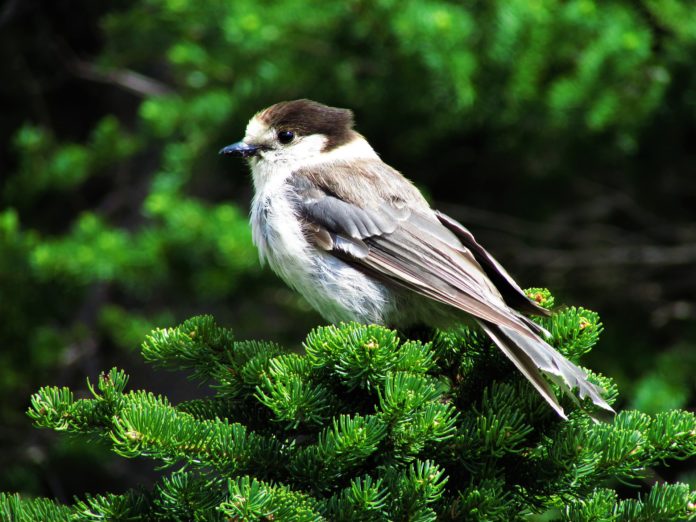The grey-feathered Canada jay — also known by the names grey jay or whiskey jack — has long been a common sight for Canadian birdwatchers from coast to coast. In fact, this member of the corvid family is so ubiquitous across Canada that it was almost recognized as the country’s national bird several years ago.
But according to a recent study, fluctuating weather patterns caused by climate change are threatening this iconic species’ food sources — and for future generations of Canada jays, this could spell disaster.
The results were led by a team of researchers from the University of Guelph and published in Global Change Biology.
Using the natural environment as a freezer
Unlike 90% of all birds that breed in Canada, Canada jays don’t migrate south during the colder winter months. Instead, these birds store thousands of food items in caches during the summer and rely on these food sources to survive in Canada year-round.
While many animals with hoarding behaviours store non-perishable food for the winter — for example, nuts — Canada jays prefer a diet of meat, berries, and other perishables. They coat these items in a layer of saliva before sticking them to high-up regions of tree branches where they’re safe from heavy snowfall.
Leaving perishable food out for months at a time may not sound like a great idea. However, temperatures in these birds’ habitats typically stay below freezing in the winter, which means that they don’t have to worry about whether or not their food will go bad.
“The Canada jay is unique,” explained Alex Sutton, a recent PhD graduate from the University of Guelph and lead author on the paper, in a press release. “It uses the natural environment as a freezer for perishable food.”
Freeze-thaw cycles pose a problem for food caches
As long as temperatures stay below freezing, this method of food caching is able to keep Canada jays fed throughout the winter months. If temperatures fluctuate above and below the freezing point, however, these cached food sources are more likely to spoil — and Canada jays will have less to eat as a result.
Thanks to climate change, these freeze-thaw cycles — days where the temperature fluctuates between freezing and non-freezing temperatures — have become increasingly common over the past few decades. And while these cycles certainly reduce the quality and quantity of Canada jays’ winter food sources, Sutton and his colleagues were interested in learning whether this was the main driver behind the species’ measured declines.
To figure this out, the team analyzed demographic data that had been collected since the 1980s in northern Ontario’s Algonquin Provincial Park, which is the oldest provincial park in Canada and has a total area of nearly 8000 square kilometres.
These long-term observations tracked the number of Canada jays present in the park over time, as well as the quantity and condition of their offspring. The initial population observed in 1980 consisted of nearly 60 Canada jays, but the authors noted that the species has been declining in the park since the late 1970s.
The team then compared trends in the demographic data to trends in the park’s climate and weather patterns. They found that years with fewer freeze-thaw cycles also tended to be years where Canada jay populations flourished — and on the other hand, years with a greater number of freeze-thaw cycles resulted in smaller, weaker offspring that were less likely to survive.
Unfortunately, even those years with fewer freeze-thaw cycles weren’t able to keep Canada jay populations afloat. The long-term demographic data revealed a steep decline in Algonquin Park’s Canada jay population over time, with fewer than 20 individual birds now present in the park — a more than 50% decrease in the park’s Canada jay population.
“If we continue to see this warming pattern in the fall, no doubt we will not see Canada jays at this location anymore,” said Ryan Norris, an associate professor in the Department of Integrative Biology at the University of Guelph and co-author on the paper.
Citizen scientists can help
While their findings are grim, the authors still have hope for Canada jay populations — and they believe that the general public can help. Increased awareness of the species could help drive conservation efforts and provide researchers with much-needed data on populations in other locations.
“[O]ur ability to predict future declines of northern populations remains limited due to insufficient data,” the authors explained in their paper.
“Citizen science databases, such as Christmas bird counts, could help to fill this gap in our knowledge.”









































